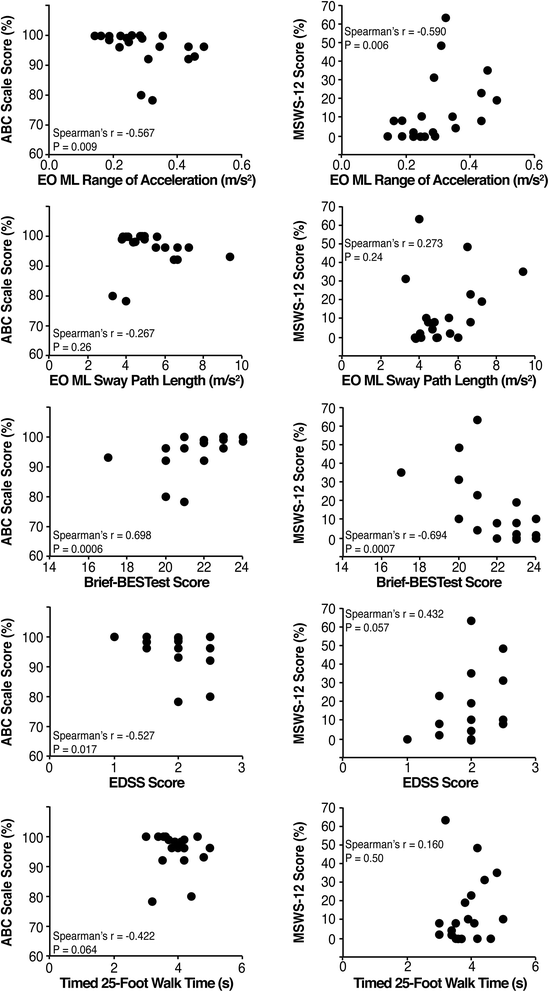Detection of postural sway abnormalities by wireless inertial sensors in minimally disabled patients with multiple sclerosis: a case-control study
- PMID: 26324067
- PMCID: PMC4556213
- DOI: 10.1186/s12984-015-0066-9
Detection of postural sway abnormalities by wireless inertial sensors in minimally disabled patients with multiple sclerosis: a case-control study
Abstract
Background: Common clinical neurological exams can be insensitive to balance and mobility impairment at the early stages of multiple sclerosis (MS) and may not correspond with patient reports. Instrumented measurement of standing postural sway with inertial motion sensors may provide sensitive measures of balance impairment and better correspond with patient reports.
Methods: While wearing wireless inertial sensors, 20 subjects with MS - Expanded Disability Status Scale of less than 3.0 and a Timed 25 Foot Walk of 5 sec or less - and 20 age- and sex-matched control subjects stood with eyes open and eyes closed on a foam surface. Forty-six outcome measures of postural sway were derived. A stepwise logistic regression model determined which measures of instrumented sway provide independent predictors of group status. Subjects with MS also completed the Activities-Specific Balance Confidence (ABC) scale and the 12-Item MS Walking Scale (MSWS-12) as measures of subject-reported balance and mobility impairment.
Results: The regression model identified medio-lateral sway path length and medio-lateral range of sway acceleration amplitude, each in the eyes-open condition, as the only two significant independent predictors to differentiate subjects with MS from those without MS (model chi-squared = 34.55, p < 0.0001): accuracy = 87.5 %, positive likelihood ratio = 6 (2.09-17.21), negative likelihood ratio = 0.12 (0.03-0.44). Range of sway acceleration amplitude significantly correlated with both ABC (Spearman's r = -0.567, p = 0.009) and MSWS-12 scores (Spearman's r = -0.590, p = 0.006).
Conclusions: Postural sway abnormalities in subjects with MS who are minimally disabled were detected using wireless inertial sensors and may signify a superior sensitivity to identify balance impairment prior to developing clinically evident disability or impaired gait speed. Further study is needed to confirm the clinical significance and predictive value of these objectively identified balance impairments.
Figures

Similar articles
-
Effects of balance-specific exercises on balance, physical activity and quality of life in adults with multiple sclerosis: a pilot investigation.Disabil Rehabil. 2015;37(24):2238-49. doi: 10.3109/09638288.2015.1019008. Epub 2015 Mar 4. Disabil Rehabil. 2015. PMID: 25738911
-
Body-worn motion sensors detect balance and gait deficits in people with multiple sclerosis who have normal walking speed.Gait Posture. 2012 Apr;35(4):573-8. doi: 10.1016/j.gaitpost.2011.11.026. Epub 2012 Jan 25. Gait Posture. 2012. PMID: 22277368 Free PMC article.
-
Impaired postural balance correlates with complex walking performance in mildly disabled persons with multiple sclerosis.NeuroRehabilitation. 2017;41(1):227-235. doi: 10.3233/NRE-171475. NeuroRehabilitation. 2017. PMID: 28527234
-
Assessing walking disability in multiple sclerosis.Mult Scler. 2012 Jul;18(7):914-24. doi: 10.1177/1352458512444498. Epub 2012 Apr 24. Mult Scler. 2012. PMID: 22740603 Review.
-
Advances in physical rehabilitation of multiple sclerosis.Curr Opin Neurol. 2020 Jun;33(3):255-261. doi: 10.1097/WCO.0000000000000816. Curr Opin Neurol. 2020. PMID: 32304436 Review.
Cited by
-
Chest-Based Wearables and Individualized Distributions for Assessing Postural Sway in Persons With Multiple Sclerosis.IEEE Trans Neural Syst Rehabil Eng. 2023;31:2132-2139. doi: 10.1109/TNSRE.2023.3267807. Epub 2023 May 2. IEEE Trans Neural Syst Rehabil Eng. 2023. PMID: 37067975 Free PMC article.
-
Inertial Measurement Unit-Based Romberg Test for Assessing Adults With Vestibular Hypofunction.IEEE J Transl Eng Health Med. 2023 Nov 17;12:245-255. doi: 10.1109/JTEHM.2023.3334238. eCollection 2024. IEEE J Transl Eng Health Med. 2023. PMID: 38196821 Free PMC article.
-
Low normal FMR1 genotype in older adult women: Psychological well-being and motor function.Arch Gerontol Geriatr. 2022 Nov-Dec;103:104789. doi: 10.1016/j.archger.2022.104789. Epub 2022 Aug 12. Arch Gerontol Geriatr. 2022. PMID: 35981426 Free PMC article.
-
Assessment of Postural Sway in Individuals with Multiple Sclerosis Using a Novel Wearable Inertial Sensor.Digit Biomark. 2018 Jan 23;2(1):1-10. doi: 10.1159/000485958. eCollection 2018 Jan-Apr. Digit Biomark. 2018. PMID: 32095755 Free PMC article.
-
APDM gait and balance measures fail to predict symptom progression rate in Parkinson's disease.Front Neurol. 2022 Nov 9;13:1041014. doi: 10.3389/fneur.2022.1041014. eCollection 2022. Front Neurol. 2022. PMID: 36438964 Free PMC article.
References
-
- Meyer-Moock S, Feng YS, Maeurer M, Dippel FW, Kohlmann T. Systematic literature review and validity evaluation of the Expanded Disability Status Scale (EDSS) and the Multiple Sclerosis Functional Composite (MSFC) in patients with multiple sclerosis. BMC Neurol. 2014;14:58. doi: 10.1186/1471-2377-14-58. - DOI - PMC - PubMed
Publication types
MeSH terms
LinkOut - more resources
Full Text Sources
Other Literature Sources
Medical

